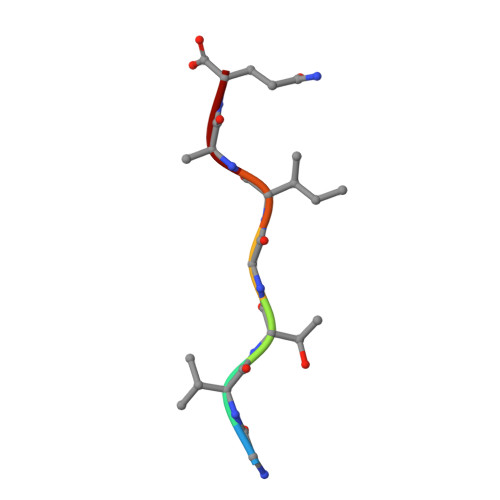Aggregation-triggering segments of SOD1 fibril formation support a common pathway for familial and sporadic ALS.
Ivanova, M.I., Sievers, S.A., Guenther, E.L., Johnson, L.M., Winkler, D.D., Galaleldeen, A., Sawaya, M.R., Hart, P.J., Eisenberg, D.S.(2014) Proc Natl Acad Sci U S A 111: 197-201
- PubMed: 24344300
- DOI: https://doi.org/10.1073/pnas.1320786110
- Primary Citation of Related Structures:
4NIN, 4NIO, 4NIP - PubMed Abstract:
ALS is a terminal disease of motor neurons that is characterized by accumulation of proteinaceous deposits in affected cells. Pathological deposition of mutated Cu/Zn superoxide dismutase (SOD1) accounts for ∼20% of the familial ALS (fALS) cases. However, understanding the molecular link between mutation and disease has been difficult, given that more than 140 different SOD1 mutants have been observed in fALS patients. In addition, the molecular origin of sporadic ALS (sALS) is unclear. By dissecting the amino acid sequence of SOD1, we identified four short segments with a high propensity for amyloid fibril formation. We find that fALS mutations in these segments do not reduce their propensity to form fibrils. The atomic structures of two fibril-forming segments from the C terminus, (101)DSVISLS(107) and (147)GVIGIAQ(153), reveal tightly packed β-sheets with steric zipper interfaces characteristic of the amyloid state. Based on these structures, we conclude that both C-terminal segments are likely to form aggregates if available for interaction. Proline substitutions in (101)DSVISLS(107) and (147)GVIGIAQ(153) impaired nucleation and fibril growth of full-length protein, confirming that these segments participate in aggregate formation. Our hypothesis is that improper protein maturation and incompletely folded states that render these aggregation-prone segments available for interaction offer a common molecular pathway for sALS and fALS.
- Howard Hughes Medical Institute, UCLA-DOE Institute for Genomics and Proteomics, and Department of Biological Chemistry, University of California, Los Angeles, CA 90095-1570.
Organizational Affiliation:
















